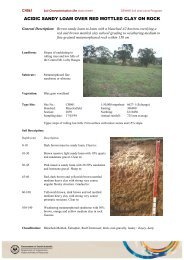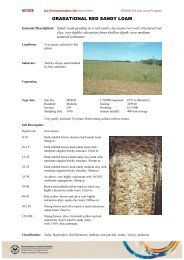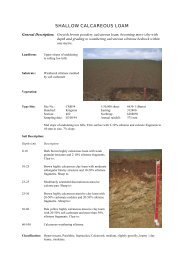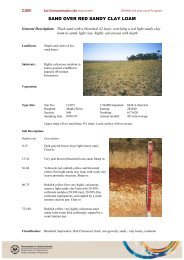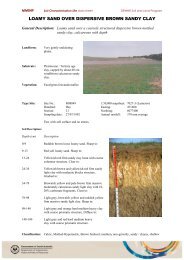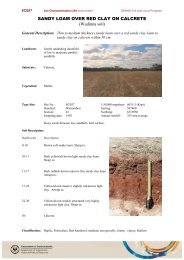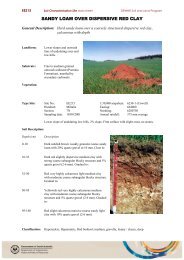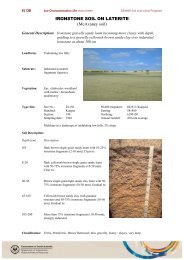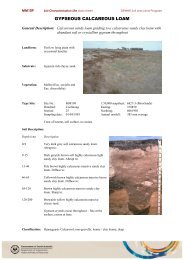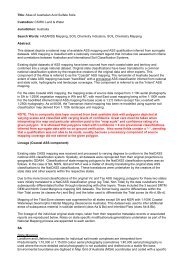You also want an ePaper? Increase the reach of your titles
YUMPU automatically turns print PDFs into web optimized ePapers that Google loves.
4.2 Upper levels of the hierarchyThe upper levels of the land-unit hierarchy are described in Sections 6–8. There are many other maps ofAustralia’s natural resources at scales equivalent to the land region, land province or land division. Someexamples relevant to soils and landscapes include:• Northcote et al. (1960–1968) – Atlas of Australian soils• Löffler and Ruxton (1969) – Relief and landform map of Australia• Laut et al. (1980) – Provisional environmental regions of Australia• CSIRO (1983) – Soil landscape regions• Grant et al. (1984) – Geotechnical landscape map of Australia• Chan (1986) – Regolith terrain map of Australia• Jennings and Mabbutt (1986) – Physiographic regions of Australia• Environment Australia (2000) – Interim Biogeographic Regions Version 5.1• Coram et al. (2001) – Groundwater flow systems• Williams et al. (2002) – Agro-ecological regions of Australia<strong>ASRIS</strong> has the facility to represent such stratifications above the level of the mapping hiatus. IBRA regions,groundwater flow systems, and catchment management boundaries are available and others will be addedif required. The ability to represent other stratifications allows summaries of soil and landscape propertiesto be generated in various formats. This promotes both integration of natural resource information andmore widespread use of soil and land data by non soil-science based groups.The line work and principles of Jennings and Mabbutt (1986) have been used to develop methods for Levels1–2 in <strong>ASRIS</strong>. In particular:• land-unit tracts at these levels are mostly discrete entities and outliers are permitted only inexceptional cases (e.g. offshore islands, major plateau adjacent to extensive tablelands)• tracts are hierarchical and have a single parent-tract• the conventions for geographic naming outlined by Jennings and Mabbutt (1986) are followedexcept where their existing terms fail to have a local resonance (e.g. Werriwa Tablelands for thenorthern section of the Southern Tablelands in New South Wales) – this judgement is made bystate and territory agency staff with reference to local naming conventions.4.2.1 Data presentationApart from the online maps, data summaries (e.g. for soil properties such as pH, exchangeable cations,hydraulic conductivity) in the <strong>ASRIS</strong> land-unit hierarchy are of two basic types:• area-weighted means (only for attributes where this is appropriate)• histograms of attributes based on percentage area.These two options, when combined with estimates of uncertainty, should form a sufficient basis for mostqueries of the system. The provision of histograms is to ensure compatibility with modelling systems suchas those used in hydrology that use distributional information rather than simple measures of centraltendency (e.g. mean, median). It is also an essential step towards providing better measures of uncertaintyfor all users of soil and land information.13




